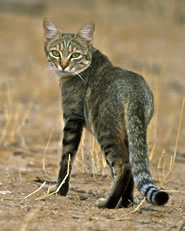 |
.gif) |
| Subscribe Renew Change address |
|
Best live jobs in the hottest areas of
sciences Cell Biology Software Engineering Genetics Analytical Chemistry Sales & Marketing Or search all of our jobs and opportunities |
| The World's No.1 Science & Technology News Service |
|
Ancient remains could be oldest pet cat | |||||||||||||||||||||||||||||||||||||||||
| 19:00 08 April 04 | |||||||||||||||||||||||||||||||||||||||||
| NewScientist.com news service | |||||||||||||||||||||||||||||||||||||||||
|
People tamed cats as pets at least 9500 years ago, say researchers who have unearthed the grave of a prehistoric tabby in Cyprus. The Stone Age moggy appears to have been carefully placed alongside a human corpse, along with offerings including jewellery and stone tools. Until now, historians thought the ancient Egyptians first domesticated cats about 4000 years ago. But evidence suggests cats were culturally important outside Egypt long before that. Stone and clay figurines of cats up to 10,000 years old have turned up in Syria, Turkey and Israel.
And archaeologists have found cat bones more than 9000 years old on the Mediterranean island of Cyprus, which has no native feline species. "The first discovery of cat bones on Cyprus showed that human beings brought cats from the mainland to the islands, but we could not decide if these cats were wild or tame," says Jean-Denis Vigne of the French research organisation CNRS and the National Museum of Natural History in Paris. Now Vigne and his colleagues have discovered the remains of a Neolithic cat at the ancient village of Shillourokambos in Cyprus, and the manner of its burial suggests the animal was a pet.
The cat belonged to the species Felis silvestris, the wild cat from which domestic cats descended. Its remains lie just 40 centimetres from a 9500-year-old human grave containing valuable offerings such as polished stones and seashells.
Furthermore, the human and cat skeletons have identical states of preservation. The skeletons were positioned symmetrically, with both heads pointing west, which may have been intentional. The cat died when it was about eight months old, and while the cause of death is a mystery, there are no signs on the bones that the animal was butchered for food. Vigne thinks the proximity of the human skeleton suggests a strong bond with the cat, which might have been killed to go to the grave with its master. It would have made sense for early agricultural societies to mingle with cats, he adds, because cats could have killed the mice that nibbled precious grain supplies. Journal reference: Science (vol 304, p 259) | |||||||||||||||||||||||||||||||||||||||||
|
Hazel Muir | |||||||||||||||||||||||||||||||||||||||||
|
|
||
| For whats in New Scientist magazine this week see Print Edition | ||
| Search the Archive for more stories like this, originally published in the Print Edition | ||
| Subscribe to New Scientist Print Edition | ||
| Contact us about this story | ||
| Sign up for our free newsletter | ||
.gif) |
 | ||||
 | ||||
 | ||||
|
All the best science stories from the
web |
|
Witty worm sets a dangerous precedent The Register |
|
The mini-car that runs on natural gas The Guardian, UK |

| ADVERTISEMENTS |
| For unbiased reviews & prices of digital
cameras use DigitalCamera-HQ.com Digital Camera Digital Cameras Digital Camera Review Digital Camera Reviews Sony Digital Camera Canon Digital Camera Camcorder Camcorders Canon 300D Digital Camera Links |
|
|
| Advice on personal & corporate finance at
Prudent Minds
Finance Guide Credit Cards Insurance Investments Loans Mortgages Pensions Savings |
|
About newscientist.com
Subscribe
Contact Us
FAQ
Media Information
Disclaimer
Terms and Conditions
Site Map
Cookies
Privacy Policy
© Copyright Reed Business Information Ltd. |
